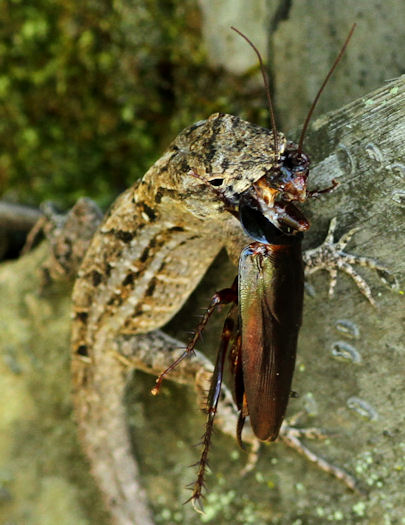
Two male green anoles (Anolis carolinensis) competing in a staged arena trial.
As anole enthusiasts, most of you have probably seen anoles engage in lock-jawed fights, where two rival males grab onto each other’s jaws and try to throw their opponent off a contested perch. These encounters are extremely physical, often leaving one or both contestants injured. While these fights are exciting to watch, they are relatively rare in nature. Most contests between anoles are resolved without fighting using stereotypical display behaviors, where the two lizards head bob and dewlap at each other until one anole submits. In these cases, dominance is conveyed not through physical defeat, but from the animals’ perceptions of their opponents.
This of course begs the question, what criteria do anoles use to evaluate their rivals? How do they decide if they should keep pushing or if they should back down during a fight? A lot of research has attempted to answer this question. Many of these studies are performed in the lab using staged contests between two individuals, called arena trials. These studies generally look for differences between the “winners” and the “losers” of each trial to identify potential dominance signals.
When I was an undergraduate in Dr. Michele Johnson’s lab at Trinity University, we ran a lot of arena trials to understand how lizards interact. At the same time, I was part of a collaborative biomath team that included McKenzie Quinn (another undergrad) and me, and our advisors Michele and mathematician Dr. Cabral Balreira. We had been working together to develop a mathematical model of lizard energy use, and as that project was wrapping up, we were considering other directions our team might pursue. We came up with the exciting idea that we might be able to use those arena trials we’d been doing in combination with Cabral’s area of expertise –the development of ranking algorithms, usually applied in sports. In Cabral’s work with sports ranking algorithms, he summarizes the win-loss results of a sports tournament to identify the overall best and worst teams. These rankings allow you to incorporate how each team performed against teams of varying skill levels, providing a more holistic metric of their abilities than individual game results would. This led us to a “light bulb” moment. By applying a sports tournament framework to a lizard population, we could see how individuals compete against different opponents to determine what traits are associated with social dominance. This also allows us to evaluate lizard dominance using quantifiable metrics instead of qualitative metrics.

(From left) Michele Johnson, McKenzie Quinn, Jordan Bush, and E. Cabral Balreira at Palmetto State Park.
We first created a tournament in which each lizard in our population (n=18) competed in six arena trials. We then used sports ranking algorithms to generate a dominance hierarchy for the population and used stepwise linear regressions to compare rank (y variable) to morphological and behavioral traits (x variables) of each lizard. We found that rank was highly predicted by aggressive behavior, indicating that lizards that displayed more during the tournament tended to be more dominant (surprisingly, body size didn’t predict dominance in our trials!). We then applied this same logic to a natural system (studying the green anoles in Palmetto State Park in Gonzales, Texas) to see if “dominant” anoles in the wild had the same characteristics as “dominant” anoles in the lab. In the wild, male anoles fight over territories, because controlling a territory gives owners uncontested access to the food and potential mates within it. Therefore we can “rank” males based on the size (bigger = better) and quality (more females = better) of their territories. When we compared territory size and quality (y variables) to morphological and behavioral traits (x variables) as before, we found that traits related to fighting ability, such as head width (a proxy for bite strength), were the best predictors of dominance in the natural system (but again, body size was not predictive of territorial success).
Together, our results indicate that dominance cues in anole contests are often context specific. In brief arena trials between unknown males, signals that reveal immediate intentions (i.e., display behaviors) are especially important. In contrast, males in the wild have to back up their bluster, and thus actual fighting ability is more highly favored in the long run. If you are interested in this study, we hope that you check out our recent paper to view the details of our results and methods.
























































